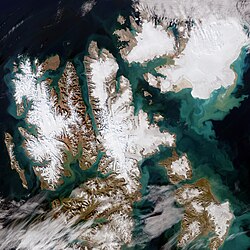
Back Svalbard ACE Svalbard Afrikaans ስቫልባር Amharic Svalbard AN Scearpbeorgas ANG स्वालबार्ड ANP سفالبارد Arabic سڤالبارد ARZ Svalbard AST Şpitsbergen Azerbaijani
Svalbard | |
|---|---|
 Satellite photo of Svalbard made by Copernicus Sentinel-2 mission, August 2022 | |
 Location of Svalbard (dark green) | |
| Sovereign state | |
| Svalbard Treaty | 9 February 1920 |
| Svalbard Act | 17 July 1925 |
| Administrative centre and largest town | Longyearbyen 78°13′N 15°39′E / 78.22°N 15.65°E |
| Official languages | Norwegian |
| Ethnic groups (2021) | 61.1% Norwegian 38.9% other[a][1] |
| Government | Devolved locally-administered unincorporated area within a constitutional monarchy |
• Monarch | Harald V |
• Governor | Lars Fause |
| Area | |
• Total | 62,045[2] km2 (23,956 sq mi) (not ranked) |
| Highest elevation | 1,718 m (5,636 ft) |
| Population | |
• 2023 estimate | 2,530[3] |
• Density | 0.044/km2 (0.1/sq mi) (248th) |
| Currency | Norwegian krone (NOK) |
| Time zone | UTC+01:00 (CET) |
• Summer (DST) | UTC+02:00 (CEST) |
| Date format | dd.mm.yyyy |
| Driving side | right |
| Calling code | +47 |
| Postal code | 917x |
| ISO 3166 code | |
| Internet TLD | |
Svalbard (/ˈsvɑːlbɑːr(d)/ SVAHL-bar(d),[4] Urban East Norwegian: [ˈsvɑ̂ːɫbɑr]), previously known as Spitsbergen or Spitzbergen, is a Norwegian archipelago in the Arctic Ocean. North of mainland Europe, it lies about midway between the northern coast of Norway and the North Pole. The islands of the group range from 74° to 81° north latitude, and from 10° to 35° east longitude. The largest island is Spitsbergen, followed in size by Nordaustlandet and Edgeøya. The largest settlement is Longyearbyen on the west coast of Spitsbergen.[5]
Whalers who sailed far north in the 17th and 18th centuries used the islands as a base; subsequently the archipelago was abandoned. Coal mining started at the beginning of the 20th century, and several permanent communities such as Pyramiden or Barentsburg were established. The Svalbard Treaty of 1920 recognizes Norwegian sovereignty, and the Norwegian Svalbard Act of 1925 made Svalbard a full part of the Kingdom of Norway. The Svalbard Treaty established Svalbard as a free economic zone and restricts the military use of the archipelago. The Norwegian Store Norske and the Russian Arktikugol remain the only mining companies in place. Research and tourism have become important supplementary industries, with the University Centre in Svalbard and the Svalbard Global Seed Vault playing critical roles in the local economy. Apart from Longyearbyen, other settlements include the Russian mining-community of Barentsburg, the Norwegian research-station of Ny-Ålesund, and the Swedish-Norwegian mining outpost of Sveagruva (which closed in 2020). Other settlements lie farther north, but are populated only by rotating groups of researchers. No roads connect the settlements; instead snowmobiles, aircraft and boats provide inter-settlement transport. Svalbard Airport serves as the main gateway.
Approximately 60% of the archipelago is covered with glaciers, and the islands feature many mountains and fjords. The archipelago has an Arctic climate, although with significantly higher temperatures than other areas at the same latitude. The flora has adapted to take advantage of the long period of midnight sun to compensate for the polar night. Many seabirds use Svalbard as a breeding ground, and it is home to polar bears, reindeer, the Arctic fox, and certain marine mammals. Seven national parks and 23 nature-reserves cover two-thirds of the archipelago, protecting the largely untouched fragile environment. Norway announced new regulations regarding tourism in February 2024, including a maximum of 200 people on a ship, to protect flora and fauna in Svalbard.[6]
While part of the Kingdom of Norway since 1925, Svalbard is not part of geographical Norway; administratively, the archipelago is not part of any Norwegian county, but forms an unincorporated area. This means that it is administered directly by the Norwegian government through an appointed governor, and is a special jurisdiction subject to the Svalbard Treaty that is outside of the Schengen Area, the Nordic Passport Union, and the European Economic Area. Svalbard and Jan Mayen are collectively assigned the ISO 3166-1 alpha-2 country-code "SJ". Both areas are administered by Norway, though they are separated by a distance of over 950 kilometres (510 nautical miles) and have very different administrative structures.
Cite error: There are <ref group=lower-alpha> tags or {{efn}} templates on this page, but the references will not show without a {{reflist|group=lower-alpha}} template or {{notelist}} template (see the help page).
- ^ "World Factbook: Svalbard". www.cia.gov. Archived from the original on 13 January 2021. Retrieved 17 April 2019.
- ^ "Svalbard". Central Intelligence Agency. 15 February 2023. Retrieved 16 March 2023 – via CIA.gov.
- ^ "Population of Svalbard". Statistics Norway. Archived from the original on 7 August 2020. Retrieved 4 July 2020. Table 2: Population in the settlements. Svalbard
- ^ "Svalbard – definition of Svalbard in English | Oxford Dictionaries". Oxford Dictionaries | English. Archived from the original on 18 September 2016. Retrieved 17 September 2016.
- ^ Dickie, Gloria (1 June 2021). "The World's Northernmost Town Is Changing Dramatically". Scientific American. 324 (6): 44–53. Archived from the original (Original title: "The Polar Crucible") on 18 May 2021. Retrieved 20 May 2021.
- ^ Cite error: The named reference
Barents2024was invoked but never defined (see the help page).
© MMXXIII Rich X Search. We shall prevail. All rights reserved. Rich X Search